A Patient’s Guide to Extensor Tendon Injuries
Introduction
An extensor tendon injury is damage to the tissues on the back of the hand and fingers. It can make it hard for you to extend your wrist, open your hand, or straighten your fingers. The inability to perform these functions can severely limit hand and upper extremity function.
A deep cut, overstretching or blunt trauma on the dorsal (top) side of your fingers, hand, wrist, or forearm can damage your extensor tendons, (often called by laymen “leaders”) which are the tissues that help control movement in your hand. An extensor tendon injury can make it impossible to extend your fingers or thumb. Certain conditions that weaken tendons (such as rheumatoid arthritis) can also be associated with spontaneous extensor tendon rupture.
Anatomy
Tendons are tissues that connect muscles to bone. When muscles contract, tendons pull on bones. This causes parts of the body (such as a finger) to move.
The muscles that move the fingers and thumb are in the forearm. Long tendons extend from these muscles through the wrist and attach to the small bones of the fingers and thumb.
The tendons on the dorsal (top) side extend the fingers and wrist. These structures are known as the extensor tendons (diagram below).
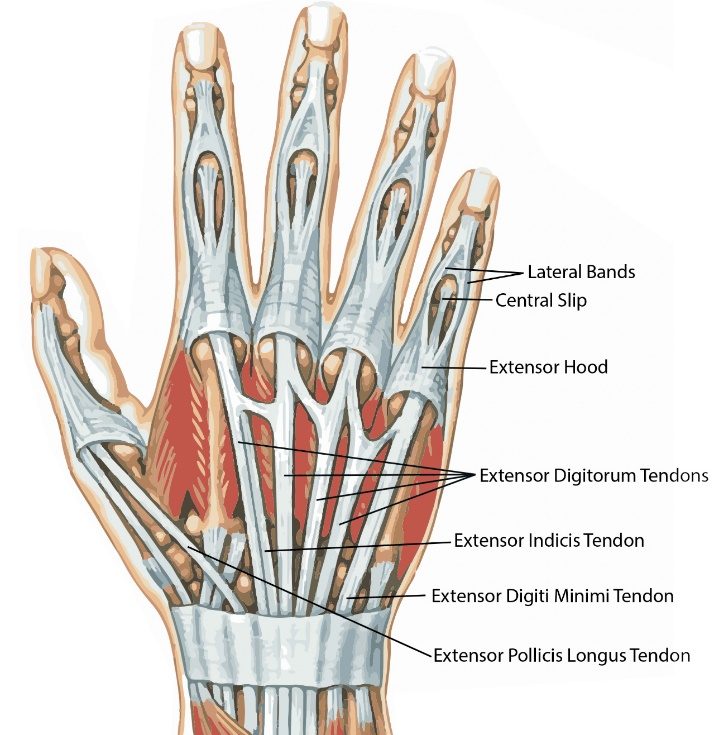
Extensor tendons allow the finger and thumb joints to straighten—laceration of the tendons of the ring finger produces the image below (ring finger):
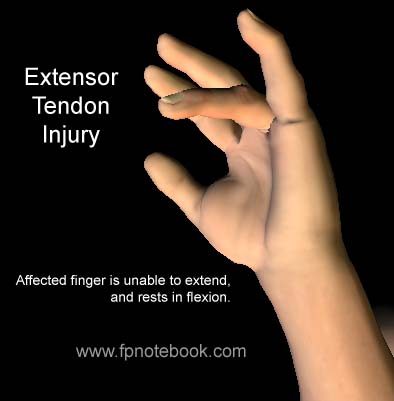
When you bend or straighten your finger, the extensor tendons slide through snug tunnels, called tendon sheaths, that keep the tendons in place next to the bones. On the bottom of the hand this system of pulleys improves mechanical efficiency. The sheaths do not improve mechanical efficiency greatly on the dorsum of the hand but are useful for hand surgeons in nomenclature (naming).
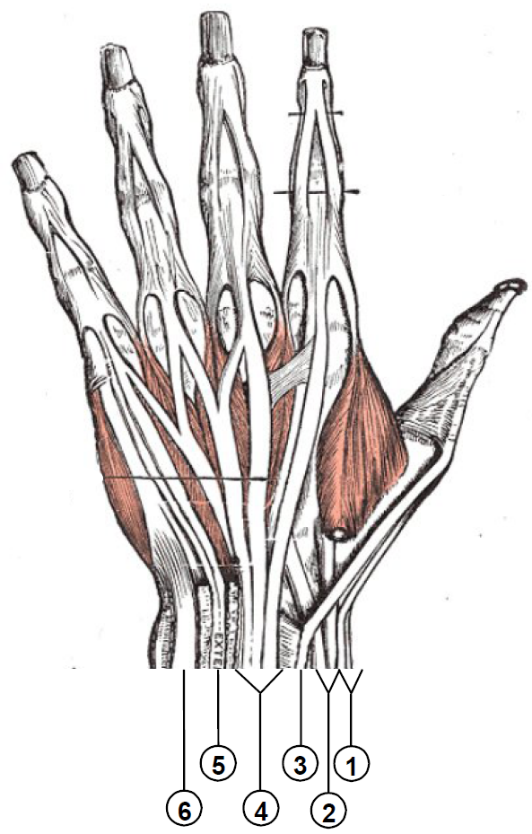
The six dorsal compartments of the wrist containing their extensor tendons.
A torn or cut tendon in the forearm, at the wrist, in the palm, or along the finger will make it impossible to extend one or more joints of the finger or wrist. Because extensor tendons are close to the surface of the skin, a deep cut will most likely hit an extensor tendon. In these cases, the tendon is often cut into two pieces. Like a rubber band, tendons are under tension as they connect the muscle to the bone. If a tendon is torn or cut, the ends of the tendon will pull far apart, making it impossible for the tendon to heal on its own.
Occasionally, extensor tendons may be partially cut or torn. With a partial tendon tear, it may still be possible to extend your finger, but not completely. These types of tears can be difficult to diagnose.
Hand Surgery Examination
The most common signs of a extensor tendon injury include:
- An open injury, such as a cut, on the dorsal side of your hand,
- An inability to extend one or more joints of your finger or wrist
- Abnormal posture of the finger or wrist at rest.
The hand surgeon then examines the hand to determine its vascular status and neurological status. The surgeon will also typically test the ability of the finger to extend at each joint. The extensor mechanism is complicated at the finger with multiple systems interacting in low tolerances to result in finger extension.
Diagnostic imaging has some limited value in evaluation of extensor tendon injuries. Some extensor tendon injuries may be avulsed with a fleck of bone and visible on routine x-rays. MRI is of limited value in diagnosis of most extensor tendon injuries.
Treatment
Non-Surgical
Some tendon injuries associated with blunt trauma or overstretching of the extensor mechanism may be preferentially treated with out surgery. Mallet finger (baseball finger) and a boutonierre injury are two of the most common extensor tendon injuries typically treated without surgery. However, the recovery can be just as long or longer than surgery for tendon injury. Nonsurgical treatment typically requires splinting and hand therapy. Results of non-surgical treatment (like surgical management) show improvement, but no treatment typically results in restoration to the preinjury status. With extensor tendon injuries some lack of motion is expected at the completion of treatment—with extensor lag and lack of full flexion a common finding.
Surgical
Almost all traumatic extensor tendon injuries require surgery (some partial lacerations less than 50% may be treated without surgery). Surgical timing depends upon the injury. If the finger has been injured and has ischemia from laceration of both digital arteries—typically expedited repair and exploration are indicated. For the isolated extensor tendon injury with a perfused finger (even with digital nerve laceration) repair within the first two weeks after injury is within the standard of care. Surgery if elective can be performed as an outpatient, utilizing a regional anesthesia. A general anesthetic is typically not necessary.
Special incisions are utilized to identify the laceration and find the two ends of the tendon. Extension of the original laceration is commonly required, as the tendon ends may have retracted. The incisions can look scary initially, but typically heal with good cosmesis.
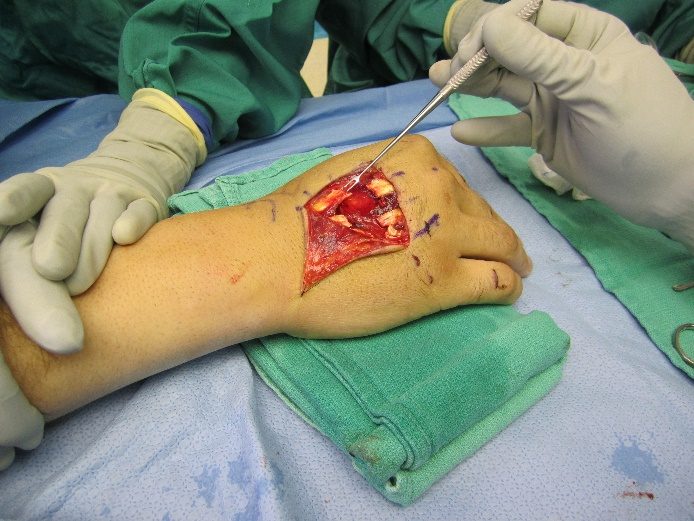
Laceration of the common digital extensors of the right hand
Recovery from Surgery
Patients are typically placed into a plaster splint which is not removable for 1-2 weeks after surgery with the fingers and wrist extended. Hand therapy and application of a plastic splint are begun between 1-2 weeks after surgery. Hand therapy is a key component to improving outcomes from tendon surgery. Hand therapy may be required 3-5 times per week for up to four months after surgery.
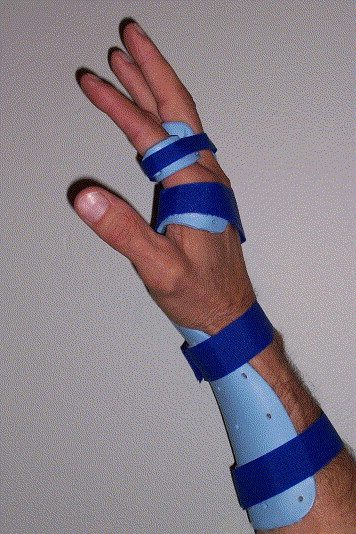
A volar blocking splint for extensor tendon injuries
It can take up to 3 months before the repair heals and your hand is strong enough to use without protection. It may take another month or so before your hand can be used with any force.
Over the last several decades, advanced research and experience in the treatment of extensor tendon injuries have resulted in improved patient outcomes. Extensor tendon injuries, however, can be challenging to treat.
Despite extensive therapy, some patients have long-term stiffness after extensor tendon injuries. Sometimes, a second surgery is required to free up scar tissue and to help the patient regain motion. Unfortunately, stiffness, tendon rupture and impaired function may all accompany long term results of extensor tendon injury.


